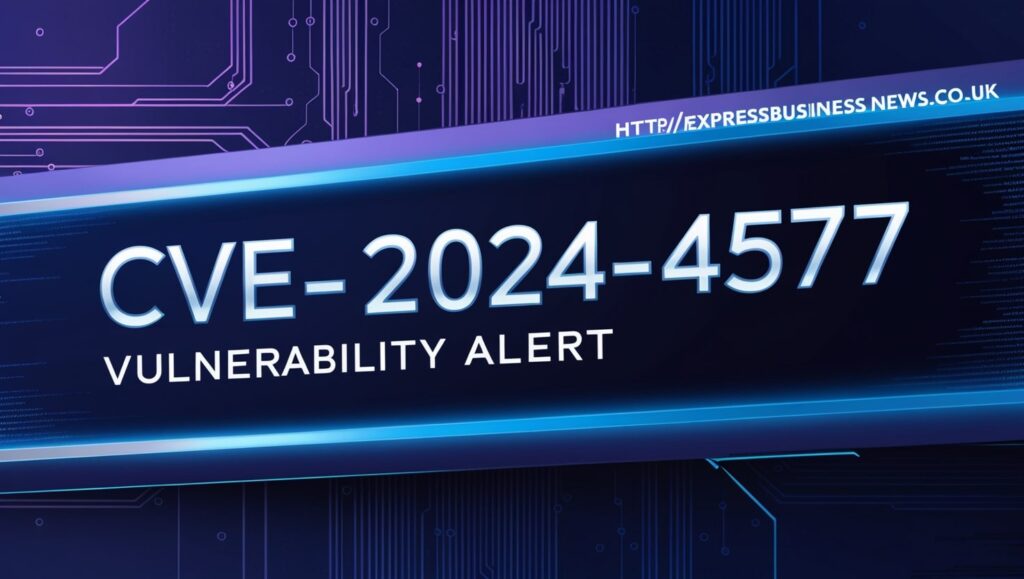Introduction to CVE-2024-4577
CVE-2024-4577 is a critical security vulnerability identified in 2024, impacting various systems and applications. This Common Vulnerabilities and Exposures (CVE) entry highlights the potential risks and implications associated with this flaw. Understanding the nature of CVE-2024-4577 is essential for cybersecurity professionals and organizations to mitigate its effects and enhance their security posture.
Overview of CVE-2024-4577
CVE-2024-4577 refers to a specific vulnerability documented in the CVE database. It describes a weakness that attackers could exploitromise the security of affected systems. The CVE entry provides a unique identifier for the vulnerability, enabling security teams to track and address the issue effectively.
The Impact of CVE-2024-4577
The impact of CVE-2024-4577 can be significant, affecting the confidentiality, integrity, and availability of affected systems. Exploitation of this vulnerability may lead to unauthorized access, data breaches, and potential disruption of services. Understanding the possible consequences helps organizations prioritize their response and mitigation efforts.
Affected Systems and Applications
CVE-2024-4577 affects a range of systems and applications, including operating systems, software applications, and network devices. Identifying the specific platforms and products impacted by this vulnerability is crucial for determining the scope of the threat and implementing appropriate security measures.
Technical Details of CVE-2024-4577
The technical details of CVE-2024-4577 involve an in-depth analysis of the nature of the vulnerability. This section explores the underlying cause of the flaw, such as coding errors, misconfigurations, or design weaknesses. Understanding the technical aspects helps in developing effective mitigation strategies and patching solutions.

Exploitation Methods for CVE-2024-4577
Exploitation methods for CVE-2024-4577 vary depending on the nature of the vulnerability. Attackers may employ different techniques, such as remote code execution, privilege escalation, or denial of service, to exploit the flaw. Analyzing these methods provides insight into potential attack vectors and helps in preparing defensive measures.
Indicators of Compromise
Recognizing indicators of compromise (IoCs) associated with CVE-2024-4577 is essential for detecting and responding to potential attacks. IoCs may include unusual network activity, unexpected system behavior, or specific patterns of exploitation. Monitoring for these signs helps identify compromised systems and initiate appropriate remediation actions.
Mitigation Strategies for CVE-2024-4577
Effective mitigation strategies for CVE-2024-4577 involve implementing security controls and best practices to reduce the risk of exploitation. These strategies include applying patches, updating software, enhancing network security, and conducting regular vulnerability assessments. Organizations should develop a comprehensive security plan to address this vulnerability.
Patching and Updates
Patching and updating are critical steps in addressing CVE-2024-4577. Vendors typically release patches or updates to fix vulnerabilities and close security gaps. It is important for organizations to promptly apply these patches to ensure their systems are protected against known exploits. Keeping software up-to-date is a fundamental aspect of cybersecurity hygiene.
Security Best Practices
Following security best practices helps organizations mitigate the risks associated with CVE-2024-4577 and other vulnerabilities. Best practices include implementing strong access controls, conducting regular security training, and employing intrusion detection systems.
Incident Response for CVE-2024-4577
An effective incident response plan is essential for addressing CVE-2024-4577-related incidents. Organizations should establish procedures for detecting, analyzing, and responding to security breaches. This includes coordinating with internal and external stakeholders, managing the containment and eradication of threats, and conducting post-incident analysis to improve future responses.
Real-World Cases of CVE-2024-4577 Exploits
Examining real-world cases of CVE-2024-4577 exploits provides valuable insights into how attackers have used the vulnerability. Case studies and incident reports highlight specific examples of exploitation, the impact on affected organizations, and the lessons learned from these incidents. Analyzing these cases helps in understanding the broader implications of the vulnerability.
Collaborating with Security Vendors
Collaborating with security vendors and experts is crucial for addressing CVE-2024-4577. Vendors may provide additional resources, tools, and support to help organizations manage and mitigate the vulnerability. Engaging with cybersecurity communities and industry groups also facilitates information sharing and enhances collective defense against emerging threats.

The Role of Threat Intelligence
Threat intelligence plays a key role in understanding and managing CVE-2024-4577. By gathering and analyzing information about current threats, attack techniques, and indicators of compromise, organizations can stay informed about evolving risks and adapt their security measures accordingly. Threat intelligence helps in proactively addressing vulnerabilities and improving overall security resilience.
Regulatory and Compliance Considerations
Regulatory and compliance considerations are important when dealing with CVE-2024-4577. Organizations must ensure that their response to the vulnerability aligns with relevant legal and regulatory requirements. Compliance with industry standards and guidelines helps in maintaining security and avoiding potential legal and financial repercussions.
The Importance of Security Awareness Training
Security awareness training is a crucial component of mitigating the risks associated with CVE-2024-4577. Educating employees about cybersecurity best practices, potential threats, and safe online behavior helps reduce the likelihood of successful attacks. Training programs should be regularly updated to address new and emerging threats.
Emerging Threats and CVE-2024-4577
Emerging threats and trends in cybersecurity can impact how CVE-2024-4577 is addressed and managed. Staying informed about new attack vectors, exploitation techniques, and advanced persistent threats helps organizations adapt their security strategies. Continuous monitoring and research are essential for staying ahead of evolving risks.
Evaluating the Effectiveness of Security Measures
Evaluating the effectiveness of security measures related to CVE-2024-4577 involves assessing the impact of implemented controls and strategies. Organizations should conduct regular security assessments, penetration testing, and vulnerability scans to ensure that their defenses are robust and effective. This ongoing evaluation helps identify areas for improvement and strengthen overall security.
The Role of Cybersecurity Policies
Cybersecurity policies play a critical role in managing CVE-2024-4577 and other vulnerabilities. Establishing clear policies and procedures for vulnerability management, incident response, and security practices helps ensure a consistent and coordinated approach to addressing security issues. Policies should be regularly reviewed and updated to reflect current threats and best practices.
Understanding the Attack Lifecycle
Understanding the attack lifecycle associated with CVE-2024-4577 provides insight into how vulnerabilities are exploited over time. The attack lifecycle includes stages such as surveillance, exploitation, and post-exploitation. By analyzing these stages, organizations can better prepare for and defend against potential attacks.
Leveraging Automation in Security
Leveraging automation in security can enhance the management of CVE-2024-4577 and other vulnerabilities. Automated tools and systems can help detect, analyze, and respond to security threats more efficiently. Automation also supports tasks such as patch management, vulnerability scanning, and incident response, improving overall security effectiveness.
The Role of Penetration Testing
Penetration testing plays a vital role in identifying and addressing CVE-2024-4577 and other security vulnerabilities. Conducting regular penetration tests helps organizations uncover potential weaknesses and assess their security posture. Penetration testers simulate real-world attacks to evaluate the effectiveness of security measures and provide recommendations for improvement.
The Impact of CVE-2024-4577 on Business Operations
The impact of CVE-2024-4577 on business operations can be significant, affecting various aspects of an organization’s functioning. Potential consequences include financial losses, reputational damage, and operational disruptions. Understanding these impacts helps organizations prioritize their response efforts and implement measures to mitigate the effects of the vulnerability.
Best Practices for Vulnerability Management
Implementing best practices for vulnerability management is essential for addressing CVE-2024-4577 effectively. This includes establishing a vulnerability management program, conducting regular assessments, and prioritizing remediation efforts based on risk. Best practices also involve maintaining an inventory of assets, tracking vulnerabilities, and ensuring timely patching and updates.
The Role of Security Audits
Security audits play a crucial role in managing CVE-2024-4577 by providing an independent assessment of an organization’s security posture. Auditors evaluate the effectiveness of security controls, identify potential vulnerabilities, and recommend improvements. Regular security audits help organizations maintain a strong security framework and ensure compliance with industry standards.

Engaging with the Cybersecurity Community
Engaging with the cybersecurity community is valuable for staying informed about CVE-2024-4577 and other emerging threats. Participating in forums, conferences, and professional networks allows organizations to share knowledge, collaborate on security initiatives, and stay updated on the latest developments in cybersecurity.
The Importance of Incident Communication
Effective incident communication is essential for managing CVE-2024-4577-related incidents. Organizations should establish clear communication channels and protocols for reporting and managing security breaches. Transparent and timely communication helps coordinate responses, address stakeholder concerns, and maintain trust during security incidents.
Future Trends in Vulnerability Management
Future trends in vulnerability management will likely influence how CVE-2024-4577 and similar vulnerabilities are addressed. Emerging technologies, evolving attack techniques, and advancements in security tools will shape the future of vulnerability management. Staying ahead of these trends helps organizations adapt their security strategies and remain resilient against evolving threats.
Conclusion: Addressing CVE-2024-4577 Effectively
Addressing CVE-2024-4577 effectively requires a comprehensive approach that includes understanding the vulnerability, implementing mitigation strategies, and continuously monitoring potential threats. By following best practices, leveraging available resources, and staying informed about emerging risks, organizations can enhance their security posture and reduce the impact of vulnerabilities.
Understanding and managing CVE-2024-4577 is a critical aspect of maintaining cybersecurity in today’s rapidly evolving threat landscape.





